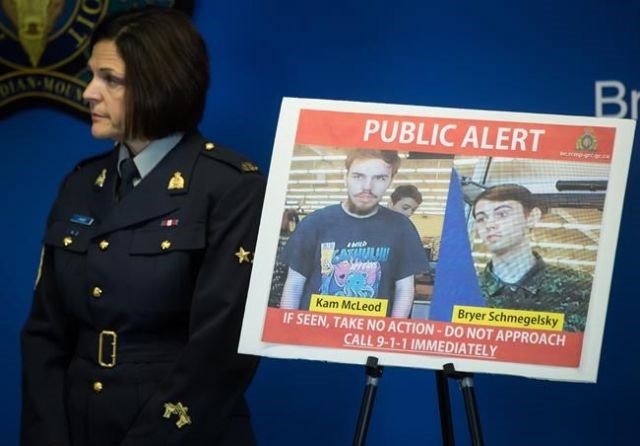Mounties have yet to determine the motive of Kam McLeod and Bryer Schmegelsky, two Port Alberni teens police say confessed, in pre-suicide videos, to killing three people in Northern B.C. in July.
RCMP held a media conference in Surrey on Friday to convey some of the information from the triple-homicide investigation. The two teens were found dead on August 7, having succumbed to self-inflicted gunshot wounds in a remote part of eastern Manitoba following a nation-wide manhunt.
Police revealed that one witness at the time and in the area of the murders could have escaped being shot amidst the killing spree.
The videos indicate the teens had at one point planned to kill more people. They also contemplated an escape from Hudson Bay to Europe or Africa on a stolen boat.
Another video contained last wishes of cremation when McLeod and Schmegelsky knew their death was imminent.
They were close to a fast-flowing river deep inside thick bush near Gillam, Man. It is believed the two got stuck between the river and an embankment they had climbed down.
Police said they will not release the series of short digital camera videos created by the two suspects out of respect for the victims’ families, and for fear that they could “sensationalize the acts of the suspects” and perhaps spur copycats.
McLeod, 19, and Schmegelsky, 18, were believed to have shot and killed tourists Chynna Deese and Lucas Fowler, as well as Vancouver resident Leonard Dyck. Crown Counsel abated the murder charges for Dyck’s death. Police did not lay charges for the deaths of Deese and Fowler prior to the suicides.
Assistant Commissioner Kevin Hackett said the investigation was “complex and fast-moving,” involving 162 officers and several agencies across numerous provinces and territories.
“The murders appear to be random and crimes of opportunity with no known motive” and for “unknown reasons,” Hackett told media.
“If there was a motive it’s obviously gone with the accused,” said Hackett.
Of the two teens’ demeanour in the videos, Hackett said “they were cold, they were remorseless.”
Police revealed Friday that on July 17, just before midnight, a male witness had pulled over to the side of the highway, two hours west of Whitehorse, Yukon, to take a nap. After five minutes, a truck being driven by two men fitting the description of McLeod and Schmegelsky pulled off in front of the man’s vehicle. One of the men got out holding a long gun, entered the bushes and proceeded to walk toward the witness vehicle. The armed man then walked out of the bush and toward the witness in a “tactical or hunting stance.”
The witness then drove off. As he passed the truck, the other man covered his face, making it difficult to determine an exact description.
This witness account occurred two days after Fort Nelson RCMP responded to a report of two deceased people near Highway 97, south of Liard Rover Hot Springs. The bodies were later identified as Fowler, a 23-year-old Australian, and Deese, a 24-year-old American, who were in a relationship and had been travelling together. Both had been shot to death, with gunshot wounds indicating the shots came from behind.
It was July 19 when Dease Lake RCMP responded to a vehicle fire on Highway 37, 60 kilometres south of Dease Lake and 546 kilometres away from the Deese and Fowler murder site. The vehicle was determined to be McLeod’s pickup truck. Dyck’s body was found just two kilometres south of the burned-out vehicle laid. He had sustained blunt-force trauma and gunshot wounds.
Police revealed there was an “escalation” from the two homicide events.
“There was a marked difference in the amount of violence that was used in the Fowler-Deese homicides and then the subsequent killing of Mr. Dyck,” said Hackett.
When police found the truck belonging to McLeod, they initially thought the two teens were missing persons. Families had told police they were “good boys.” After accounts from witnesses along the Northern B.C. highways, and evidence discovered at the crime scenes, they became suspects.
McLeod and Schmegelsky left for Northern B.C. from Port Alberni on July 12. They told family they were looking for jobs in Yukon. Police learned McLeod legally purchased one SKS semi-automatic rifle and 20 rounds of ammunition in Nanaimo that day. It was that ammo that was found at both crime scenes and at the resting place of their bodies.
McLeod and Schmegelsky stole Dyck’s Toyota RAV4 and spent days travelling to Manitoba as Mounties led the manhunt. Before leaving for Manitoba, they purchased red tape in a store in Vanderhoof, B.C. and put racing stripes on the RAV4.
The teens entered the First Nations reserve of Split Lake, Manitoba on July 22. They were questioned by band constables at a checkpoint as to their reason for visiting and the teens explained they were fuelling up. On July 23, RCMP located Dyck’s burned RAV4 in Gillam.
A boat found along the river is no longer believed to be related to the manhunt, police said.
Hackett said the RCMP is satisfied that there are no other victims.
The manhunt was an international news story given its uniqueness and the fact it affected American and Australian citizens.
It also rocked the small B.C. town of Port Alberni.
On Friday, Port Alberni Mayor Sharie Minions thanked RCMP for the report and sent condolences on behalf of the town to the victims.
— Graeme Wood, Glacier Media






